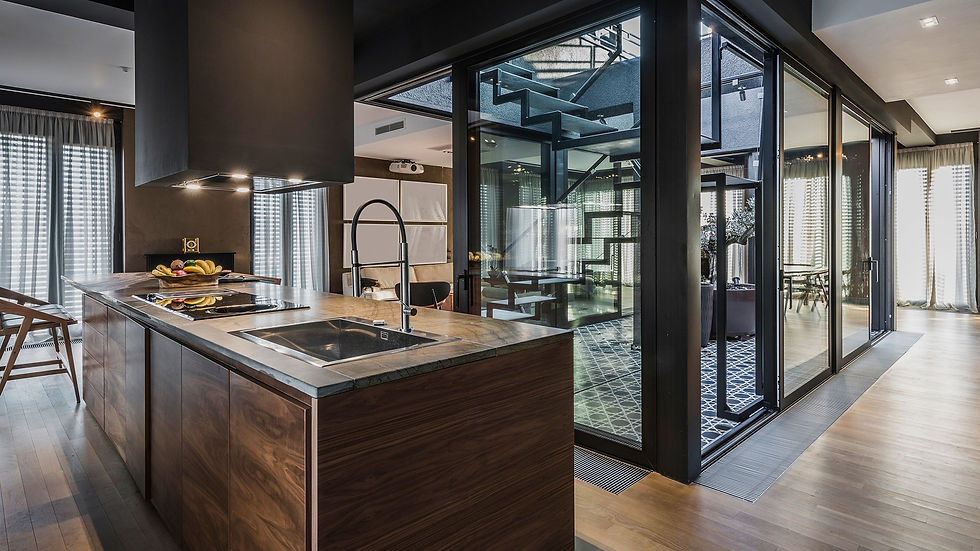The Pathway to an Organic Modern Kitchen: Designing Our Dream Kitchen
- BLOU INK

- Feb 10
- 4 min read
Updated: Nov 19

In our ever-changing world, there's a growing awareness regarding sustainability and the preservation of our planet. Every day, more people look for ways to incorporate eco-friendly practices into their lives. And it doesn't end with recycling or driving less; our homes, particularly when designing our dream kitchens, can also contribute significantly to our sustainability.
Your kitchen is the place that helps you sustain the life of all the inhabitants in your home, furry members included, so it is important that we are mindful not only of what we are putting into them, but also what they come in contact with.
Here are some insights and suggestions when designing your organic modern kitchen to make sure that you don't compromise on style or functionality.
1. Understand Your Space (Designing our dream kitchen)
The first step in designing a kitchen is understanding your space. Note the dimensions, the locations of windows and doors, and the general flow of the area. Does your kitchen open into your living space, or is it a separate room? The layout will significantly impact your design choices, from the placement of appliances to the type and amount of storage you'll need.

2. Prioritize the Work Triangle
The "work triangle" – the optimal distance between your stove, refrigerator, and sink – is a fundamental concept in kitchen design. The goal is to minimize steps between these crucial areas to enhance efficiency. Typically, the total distance of the triangle should be no more than 26 feet, with each leg measuring between 4 and 9 feet.
3. Maximize Storage
One can never have too much storage in a kitchen. Clever storage solutions can make your kitchen look tidy, organized, and larger than it is. Think about incorporating a mix of open and closed storage: open shelving for decorative items and dishes, and closed cabinets for less attractive essentials. Consider innovative storage solutions like pull-out pantries, corner drawers, and custom-built cabinetry to maximize every inch of space.

4. Add a Kitchen Island
If space allows, a kitchen island can be a game-changer. It adds counter space, storage, and can also double as a dining area. It becomes a hub for family gatherings, casual meals, and even a workspace for your kids' homework.

5. Choose Sustainable Materials
To design a sustainable kitchen, you have to think about every aspect, from the floor to the ceiling. Opt for environmentally-friendly materials that are sustainably sourced or recycled. Bamboo, cork, and reclaimed wood are great options for flooring as they are durable and come from renewable resources. For countertops, consider using recycled glass, concrete, or marble. All are beautiful, functional, and long-lasting materials. When it comes to cabinetry, choose FSC-certified wood or reclaimed wood. These materials not only bring an organic feel to your kitchen but also ensure responsible forest management and decreased environmental impact.
6. Energy-Efficient Appliances
Energy-efficient appliances are vital for a sustainable kitchen. They use less energy, reducing both your carbon footprint and your energy bills. Look for ENERGY STAR certified appliances, including refrigerators, dishwashers, and ovens. These appliances meet strict efficiency guidelines set by the U.S. Environmental Protection Agency and the U.S. Department of Energy.
7. Consider Natural Lighting
Nothing beats the warmth and glow of natural light. It reduces the need for artificial lighting during the day, helping you save energy. Consider adding skylights or enlarging windows to let in as much light as possible. For times when artificial light is necessary, use LED or CFL light bulbs that last longer and use significantly less energy than traditional incandescent bulbs.
Lighting is often overlooked in kitchen design, but it plays a significant role. Layer your lighting to ensure your kitchen is well-lit, combining ambient (general), task, and accent lighting. Consider pendant lights over the island, under-cabinet lights for countertop tasks, and recessed lighting for overall illumination.
8. Water Purification & Conservation
In a sustainable kitchen, water usage is a crucial consideration. Install low-flow faucets and consider a dishwasher that's water-efficient. You can also implement a system to reuse greywater from your sink or dishwasher to water your plants. In addition, what comes out of your sink is also important. It might be a great idea to install either a whole home water purification system or even one designated just for the kitchen sink. This provides you with safer and cleaner drinking water.

9. Optimize for Recycling and Composting
Plan a system for easy recycling and composting. Having designated bins within reach can make this process seamless and convenient. Composting your kitchen waste is a great way to reduce the amount of waste that goes to the landfill and provides you with nutrient-rich compost for your garden.
10. Use Non-Toxic Finishes
Opt for non-toxic finishes on your cabinets, counters, and walls. Many traditional paints and finishes release Volatile Organic Compounds (VOCs) into the air, which can harm indoor air quality. Luckily, there are numerous non-toxic, low-VOC, and VOC-free options available today.
An organic modern kitchen is the perfect blend of conscious material selection, energy efficiency, water conservation, and waste reduction. With these tips and tricks, you're well on your way to having an eco-friendly kitchen that combines both modernity and sustainability and most importantly, a space that feels good to be in. It's a step forward towards a more sustainable lifestyle and a healthier planet.






Comments